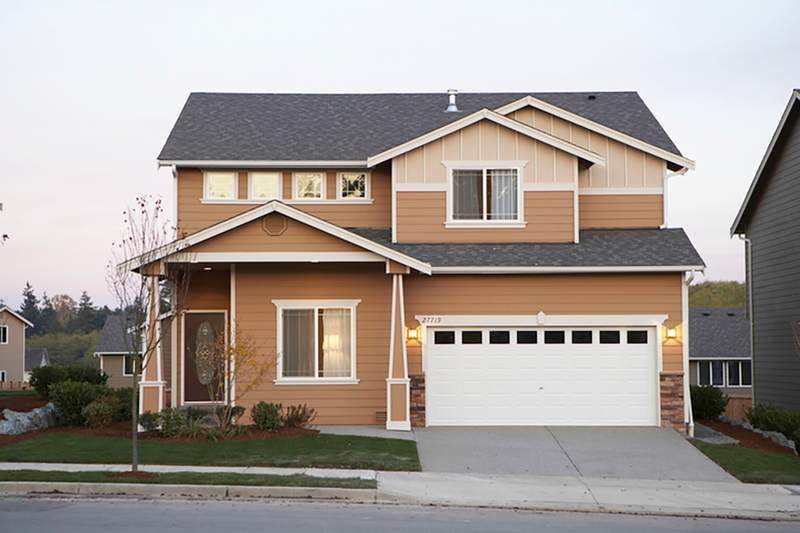If you’re looking to get some financial relief, you might be able to lower your monthly mortgage payment in a few ways. These include refinancing your mortgage to one with a lower interest rate, lengthening the repayment term of your loan or eliminating private mortgage insurance and the monthly fee that comes with it.
If your income has taken a hit, lowering your monthly mortgage payment could provide a boost to your financial health.
How To Lower Your Monthly Mortgage Payment
You have several options for lowering your monthly mortgage payment. If one of the options described next works for your situation, you could decrease the amount of money you spend on your mortgage each month.
1. Refinance To A Lower Interest Rate
Refinancing your existing mortgage loan to a new loan with a lower interest rate is one way to lower your monthly payment. By refinancing to a lower rate, you can shave hundreds of dollars off your monthly mortgage payment.
Let’s say you’re paying off a 30-year, fixed-rate mortgage of $350,000 with an interest rate of 6.81%. Your monthly payment, not including property taxes or homeowners insurance, would be $2,284.
Suppose you’ve been paying off your home loan and the current balance is down to $310,000. If you refinance that $310,000 to a 30-year, fixed-rate mortgage with an interest rate of 6%, your new monthly payment (excluding insurance and taxes) would be $1,858. With the refinance, you’ve lowered your monthly payment by $426, which means you’ll save more than $5,100 a year.
There are some caveats, though: In an environment where mortgage interest rates are higher, you might not be able to refinance to a lower rate. If the interest rate on your existing mortgage is lower than current refinance rates, you might want to hold off on refinancing for now.
You can also expect to pay from 3% to 6% of your loan’s outstanding balance in closing costs, which include items like the cost of the appraisal, discount points and origination fees. If you owe $300,000, you can anticipate paying a minimum of $9,000 to close a refinance. Keep in mind that you can typically roll these closing costs into your new mortgage balance.
2. Remove Mortgage Insurance
If you take out a conventional loan and have less than 20% equity in your home, you’ll be required to pay for private mortgage insurance. This type of insurance protects lenders in case you stop making your mortgage payments.
The price of PMI varies, but you can expect to pay from 0.1% to 2% of your loan amount each year. If you take out a $300,000 loan, your PMI can range from $300 to $6,000 a year.
With an FHA loan, or a home loan insured by the Federal Housing Administration, you’ll pay a mortgage insurance premium. There are two types of MIP. The first is your loan’s upfront MIP, which comes out to 1.75% of your loan amount. For a $300,000 mortgage, the cost of upfront MIP is about $5,250 – an amount you can typically roll into your total loan balance.
You’ll also have to pay an annual MIP on an FHA loan. This amount varies depending on a few factors, including the size of the loan, the loan repayment term and the loan-to-value ratio. The amount you’ll pay in annual MIP is broken down and included as part of your 12 monthly payments each year.
What’s Your Goal?
Buy A Home
Discover mortgage options that fit your unique financial needs.

Refinance
Refinance your mortgage to have more money for what matters.
Tap Into Equity
Use your home’s equity and unlock cash to achieve your goals.
How To Remove Private Mortgage Insurance
You can request that your loan servicer remove PMI from your loan when the principal balance of your mortgage is scheduled to fall to 80% or less of the home’s original market value. Your lender is required to give you this date in writing on the PMI disclosure form you receive when closing on your mortgage.
To request that your lender remove PMI, you’ll need to send a written letter and be current on your mortgage payments. Your lender might also require that you have your home appraised to make sure it hasn’t fallen in value since you took out your mortgage.
Your lender will automatically remove PMI on the date when your principal balance is scheduled to hit 78% of the original value of your home. Your lender will send you a letter explaining that it has removed PMI when you reach this threshold. The letter will also state your new, lower monthly mortgage payment.
How much removing PMI reduces your mortgage payment will depend on how much you’re paying each year for this insurance. If you’re paying $2,400 a year for PMI, removing it will reduce your monthly mortgage payment by $200 ($2,400 ∕ 12 months = $200).
How To Remove A Mortgage Insurance Premium
Most homeowners with an FHA loan will have to pay MIP for the life of their loan. However, if you made a down payment of 10% or more when taking out your loan, you can request that your lender remove your MIP after you’ve made 11 years of payments.
Another way to potentially remove annual MIP is to refinance from an FHA loan to a conventional mortgage. However, you’ll need at least 20% equity in your home to avoid paying PMI after refinancing, and you may need 20% equity to refinance at all.
If you apply for a refinance, your lender will typically order an appraisal to determine your home’s current market value. Subtracting the amount you still owe on the mortgage from the current market value will reveal the amount of equity you have.
3. Change Your Mortgage Loan Term
If you’re currently in a shorter-term mortgage, such as a 15-year fixed-rate loan, you can reduce the size of your monthly mortgage payment by refinancing to a loan – such as a 30-year fixed-rate loan – with a longer repayment period.
Let’s say you’re paying off a $350,000 15-year, fixed-rate mortgage with an interest rate of 4.5%. Your monthly payment, not including taxes or insurance, would be $2,677. Let’s also suppose you owe $310,000 on that mortgage and you refinance that amount to a 30-year, fixed-rate mortgage with an interest rate of 6%. Your new monthly payment, without taxes and insurance, would be $1,858 – or a savings of $819 a month.
There are some negatives to consider here, though. You’ll pay more in interest if you refinance to a longer loan term. In the example above, with the 30-year fixed-rate mortgage, you’ll pay a total of $359,489 in interest if you take the full 30 years to repay what you borrowed. If you stuck with the 15-year fixed-rate loan at an interest rate of 4.5%, you’d only pay $131,982 in interest if you took the full 15 years to repay what you borrowed.
4. Recast Your Mortgage
A less common option for reducing your mortgage payment is mortgage recasting. The only challenge here is that you’ll need a large sum of money to make a recast happen.
Suppose you come into extra money, whether from an inheritance, a large bonus at work, a royalty payment, a legal settlement or some other type of financial windfall. You can make a large lump-sum payment to reduce your mortgage loan’s principal balance. This will lower the amount you owe on your loan and reduce your monthly payment.
With a mortgage recast, your loan’s term won’t change. If you took out a 30-year fixed-rate mortgage, you’ll still be left with a 30-year repayment term. But because you reduced the loan’s principal balance, you’ll need to pay less each month to pay off what you borrowed by the time your loan reaches its 30-year term.
Ready To Refinance?
Get matched with a lender that can help you reach your financial goals.
5. Look For A Lower Homeowners Insurance Rate
When you apply for a mortgage, your lender will require that you take out a homeowners insurance policy. Typically, you’ll pay a portion of your yearly homeowners insurance cost with each mortgage payment. If you can lower the cost of your policy, it’ll decrease your monthly expense.
Your policy cost will be largely based on factors outside your control, such as the size of your home, its age and location. It’s typically possible to lower the cost of your policy by taking such steps as adding a security system, installing roofing materials that offer added protection against hail and affixing wind-resistant shutters to your windows.
You can also potentially reduce how much you pay by changing homeowners insurance providers. If you shop for a new homeowners insurance policy, you might land one at a lower rate.
6. Rent Out Part Of Your Home
It won’t lower your mortgage payment, but renting out a room or floor in your home will provide monthly rental income you can use to help cover your monthly mortgage payment. If you’re struggling to make your payment each month, this extra influx of cash could help.
You might consider a “house hack” of part of your home. With this strategy, you’ll rent out a room or several rooms in your home while you share certain common areas – such as your kitchen and bathrooms – with your renters.
7. Appeal Your Property Taxes
Most lenders require home buyers to open an escrow account when they take out a mortgage. With every mortgage payment you make, a portion of that money will go into this account. When homeowners need to pay property taxes and homeowners insurance, their lender will make these payments on their behalf.
If you can lower your property taxes, your monthly payments won’t be as large. Doing this isn’t easy though, as it’ll require filing an appeal with your county assessor. The assessor’s office will then review your property taxes to determine if you’re paying too much. A successful appeal could result in a lower property tax bill and ultimately a lower payment.
View Your Refinancing Options
Find a refinance lender that will work with your unique financial situations.
FAQ
Wondering how to lower your mortgage payment? Here are some of the most common questions that homeowners ask, followed by the answers.
The Bottom Line
If your monthly mortgage payments are too high, you can take steps to lower them. Ways to go about this include refinancing, removing mortgage insurance, lowering your property tax bill and reducing the amount you pay each month in homeowners insurance.

Dan Rafter
Dan Rafter has been writing about personal finance for more than 15 years. He's written for publications such as The Washington Post, Chicago Tribune and Wise Bread.












